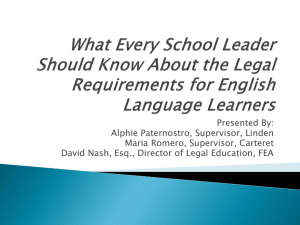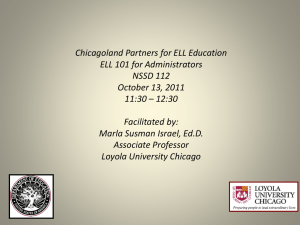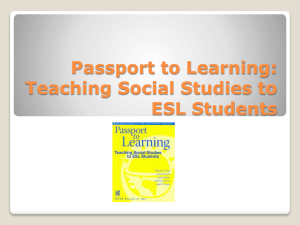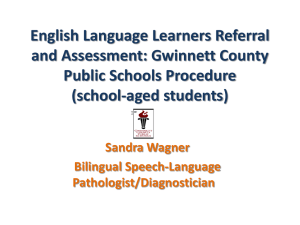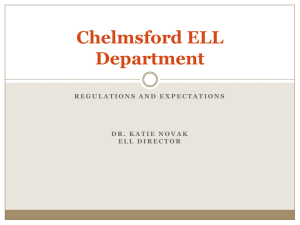Policy 342.7-Rule - Procedures for Testing & Assisting English
advertisement
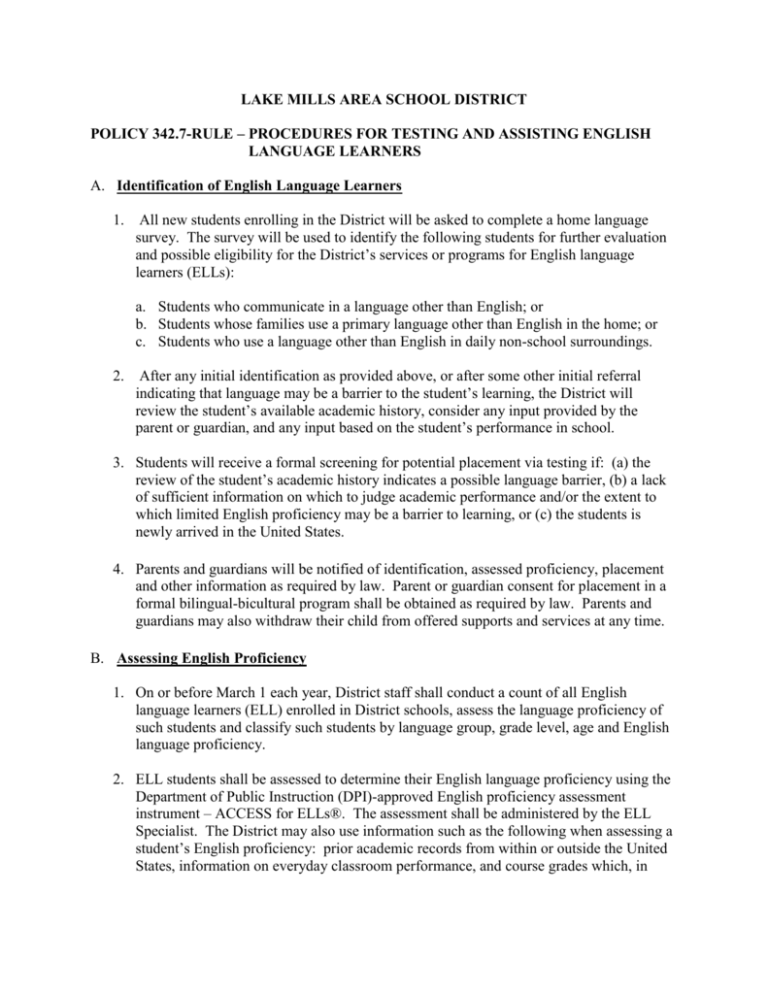
LAKE MILLS AREA SCHOOL DISTRICT POLICY 342.7-RULE – PROCEDURES FOR TESTING AND ASSISTING ENGLISH LANGUAGE LEARNERS A. Identification of English Language Learners 1. All new students enrolling in the District will be asked to complete a home language survey. The survey will be used to identify the following students for further evaluation and possible eligibility for the District’s services or programs for English language learners (ELLs): a. Students who communicate in a language other than English; or b. Students whose families use a primary language other than English in the home; or c. Students who use a language other than English in daily non-school surroundings. 2. After any initial identification as provided above, or after some other initial referral indicating that language may be a barrier to the student’s learning, the District will review the student’s available academic history, consider any input provided by the parent or guardian, and any input based on the student’s performance in school. 3. Students will receive a formal screening for potential placement via testing if: (a) the review of the student’s academic history indicates a possible language barrier, (b) a lack of sufficient information on which to judge academic performance and/or the extent to which limited English proficiency may be a barrier to learning, or (c) the students is newly arrived in the United States. 4. Parents and guardians will be notified of identification, assessed proficiency, placement and other information as required by law. Parent or guardian consent for placement in a formal bilingual-bicultural program shall be obtained as required by law. Parents and guardians may also withdraw their child from offered supports and services at any time. B. Assessing English Proficiency 1. On or before March 1 each year, District staff shall conduct a count of all English language learners (ELL) enrolled in District schools, assess the language proficiency of such students and classify such students by language group, grade level, age and English language proficiency. 2. ELL students shall be assessed to determine their English language proficiency using the Department of Public Instruction (DPI)-approved English proficiency assessment instrument – ACCESS for ELLs®. The assessment shall be administered by the ELL Specialist. The District may also use information such as the following when assessing a student’s English proficiency: prior academic records from within or outside the United States, information on everyday classroom performance, and course grades which, in relation to the student’s grade level, indicate that lack of progress is due to limited English language skills. 3. ELL students assessed shall be classified and reclassified as appropriate, according to their English proficiency level as outlined in state rules (Level 1 – Beginning Preproduction through Level 6 – Formerly Limited-English Proficient Now Fully-English Proficient). 4. Student English proficiency assessment records shall be maintained by the District in accordance with state and federal laws and District student records policies and procedures. Reports regarding ELL students shall be made to the DPI as legally required. C. Assessing Academic Performance Decisions regarding academic performance and assessment shall be made on an individual basis for each ELL student, and information on both academic and English proficiency data shall be documented and considered. Decisions regarding the appropriate approach to assessment, including the planned approach for the student’s state-mandated academic assessments, shall be made by the ELL Specialist and the Building Administrator and communicated to the student’s parent(s) or guardian. D. ELL Students and State Academic Assessments 1. The results of both state-required tests and alternative assessments shall be used in a manner that is consistent with District policies in making instructional, promotion and graduation decisions. Test results may not be used as the sole criterion in re-classifying an ELL student from a bilingual-bicultural education program or in determining grade promotion, eligibility for courses or programs, eligibility for graduation or eligibility for participation in post-secondary education opportunities. Similarly, exemption of an ELL student from taking a state-required test may also not be used as the sole criterion for making such determinations. 2. The District shall administer a state-required test to an ELL student unless a determination has been made that the results of the test, with allowable accommodations made for the student as needed, will not be a valid and reliable indicator of the student’s academic knowledge and skills. Such determinations are to be made on an individualized, case-by-case basis. If an ELL student is exempted from taking a staterequired test, he/she shall be administered a DPI-approved alternative assessment. a. Before making decisions regarding state-required academic assessments for any ELL student, the District will first determine if the student has recently arrived in the United States. “Recently arrived” refers to a student that has attended a U.S. school for less than 12 months. (1) A recently arrived ELL student may be exempted from one required administration of the state’s reading assessment. (2) Recently arrived students must participate in all other content areas (with or without accommodations). (3) If the District does not assess a recently arrived ELL student on the state’s reading/language arts assessment, the District must count the year in which the assessment would have been administered as the first of the three years in which the student may take the state’s reading/language arts assessment in an alternative format (see paragraph b in this section, immediately below). b. Except as specified below in b(1) and b(2), students at English proficiency Level 1 or Level 2 as defined by the state English proficiency level standards shall participate in an alternative assessment even if they participate in a state-required test. (1) Students at English proficiency levels 1 or 2 who have attended school in the first grade or any higher grade in the United States, not including Puerto Rico, for three or more full consecutive school years shall participate in academic assessment of reading or English language arts using tests written in English. (2) The District may continue, for no more than two additional consecutive school years, to assess a student described in (1), immediately above, with an alternate assessment, rather than the state-required tests, if the District determines that the student has not reached a level of English language proficiency sufficient for the tests written in English to yield valid and reliable information about what the student knows and can do. This determination shall be made on a case-by-case basis. c. Students at English proficiency levels 3 through 5 as defined by the state English proficiency level standards shall participate in a state-required test but may also participate in an alternative assessment, based upon the District’s assessment of the student’s overall academic performance and its determination as to whether the alternative assessment and the results obtained from the assessment are likely to be beneficial to the student. d. If an ELL student participates in a state-required test, the District shall provide testing accommodations for the student if they are needed. Any accommodations made shall maintain the validity of the test. Testing accommodations may include, but are not limited to, one or more of the following: (1) providing the assistance of a qualified translator to translate instructions or read items from tests that do not assess English language competency; (2) providing small group or individual testing opportunities; (3) providing more practice tests or examples before the actual test is administered; (4) allowing ELL students to use dictionaries or other educational aids while taking the test unless this use would invalidate the test; (5) allowing ELL students as much time as necessary to complete the test; and (6) any other accommodation approved by the DPI. 3. School personnel shall make reasonable efforts to consult with a student’s parent or guardian regarding the planned approach to the student’s state-required academic assessments. 4. Student test/alternative assessment results shall be communicated to the student’s parent or guardian and to the DPI as required by law. E. Educational Program Assistance 1. An ELL student will be provided educational program assistance and/or services as appropriate and necessary to help the student improve his/her English language skills and academic performance. The degree of curricular and instructional modification, type of support or other program services and their duration shall be determined individually, based on student need. F. Students Exiting the ELL Program Based on Proficiency 1. An ELL student will be exited from the ELL program or services when the student earns a 6.0 composite score on the ACCESS for ELLs®. 2. An ELL student may also be eligible for exiting from the ELL program or services if all of the following conditions are met: a. The student has completed fourth grade. b. The student has attained an English level proficiency of level 5. c. Two or more additional pieces of evidence demonstrate that the student has become fully English language proficient. Examples of such evidence are: district/school writing samples meet or exceed grade level expectations; the student’s scores are in the proficient or advanced categories on the Wisconsin Knowledge and Concepts Examination without ELL accommodations in reading and math; the student scores at 5.5 or better on the reading portion of the ACCESS for ELLs® without the use of adapted or modified materials. d. The student’s parent(s) or guardian and teachers agree that the student has reached full English proficiency. 3. Once students have been exited from the ELL program, they shall no longer be tested on their English proficiency or receive state testing accommodations for ELL students. However, the District will continue to monitor the exiting student for two additional years through teacher observation and by documenting adequate progress/classroom performance. If it is determined that the student was exited from the ELL program prematurely, he/she will be placed back in the ELL program and provided appropriate services. G. Notices and Other Communications with Parents and Guardians District personnel are expected to make reasonable efforts to present formal notices and other information to parents and guardians in an understandable format and in a language parents and guardians can understand. Notices and communications may be provided in the parent’s or guardian’s primary language (preferred with practical, and required by law in some instances), in English with additional explanation, or via other means that sufficiently convey the required information (e.g., using direct translation assistance if available and if necessary). Approved: 1/13/14

